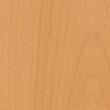Beech
Fagus silvatica L.
Green density
Average value
712 kg/m³
Total degree of shrinkage
axial
0,3 %
radial
5,8 %
tangential
11,8 %
Differential swelling
radial
0,20 %%
tangential
0,41 %%
Other characteristics
Thermal conductivity
0,16 W/mK
Equilibrium of moisture
content (20°/37%)
content (20°/37%)
7,3 %
Equilibrium of moisture
content (20°/83%)
content (20°/83%)
15,7 %
Hardness
Brinell hardness HB,0
72 N/mm²
Brinell hardness HB,90
34 N/mm²
Elastic properties
Flexural modulus of elasticity
16000 N/mm²
Strength properties
Flexural strength
123 N/mm²
Tensile strength
135 N/mm²
Compression strength
62 N/mm²
Natural durability
Fungi
5, non-durable
Anobium
S, susceptible
Treatability
Heartwood
1, highly permeable
Sapwood
1, highly permeable
Characteristic values determined from wood samples with a moisture content of 12%.
Common Beech (Fagus silvatica) is a beautiful tree which grows straight and is our most common deciduous tree.
Beechwood is heavy, hard and pressure-resistant, yet it can be worked easily and, due to its even structure, makes for good staining, steam-heating and polishing.
In its natural state, it ranges from yellowish-white to reddish in colour, often developing a false-coloured centre which gives especially furniture a lively appearance.
Beechwood is widely used in furniture making and for interior fittings.
Beechwood is heavy, hard and pressure-resistant, yet it can be worked easily and, due to its even structure, makes for good staining, steam-heating and polishing.
In its natural state, it ranges from yellowish-white to reddish in colour, often developing a false-coloured centre which gives especially furniture a lively appearance.
Beechwood is widely used in furniture making and for interior fittings.



